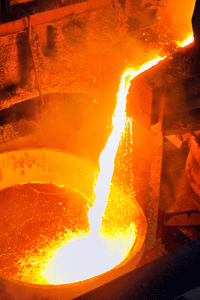Melting Metals

Contact Us
Meltingbar, LLC740 Sansom Street
Suite 202
Philadelphia, PA 19107
Office: 215.627.GOLD(4653)
Fax: 267.886.8014
info@meltingbar.com
Directions
Metal Refining
Refining begins with melting down the jewelry. The metal melting points differ, but they all require high temperatures. The gold melting point is nearly 2000 degrees Fahrenheit, while the silver melting point is nearly 1800 degrees, and the platinum melting point is more than 3200 degrees.Refining the Metals
Once in their molten forms, the metals are poured into an ice water bath that reduces the particle size and creates metal bars. The bars are then dissolved in an acid mixture. The dissolved metals are now in liquid, though not molten, form. The solution is neutralized with urea. Sulfur dioxide is then injected into the solution, which causes the gold in the solution to drop to the bottom of the tank. The solution is removed from the tank revealing a “yellow mud” at the bottom. This is gold that is roughly 99 percent pure. The gold is then washed with sulfuric acid to remove any remaining bits of other metals. A final wash with de-ionized water through a highly efficient filtering system is done. What now remains is a cake of gold powder that is melted at 2200 degrees Fahrenheit and poured into bars. The refining is not complete, though, because the acid solution still has other metals in it. Ammonia is added to this solution to raise the pH level and remove silver. A coagulant is added to remove copper. At the end of the process, all that is left is salty water.
Metal Roasting
Roasting is used to convert base metals, such as zinc, iron, lead and copper, to their respective oxides so that they can be easily removed into a slag during subsequent smelting process. Any minor amount of sulphides in the roasted material is also oxidized. Oxidation is most effectively performed in the range 600-700 oC to enable conversion to the oxide within practical time scales, typically 12-18 hours, although temperatures well in excess of 700 oC have been used in practice to reduce roasting time. Above 600 oC most metals of importance have negative free energy of formation values, implying that the oxide should be formed under these conditions. Slow roasting conditions are generally more efficient for converting these metals to their oxides; the reaction is usually limited by the mass transport of oxygen to the metal surfaces and an adequate flow of oxygen, as air, must be provided to all regions of the material. Thin layers of material (40-80 mm thick) in roaster-calciner trays should be used and care should be taken not to pack the material.
Chemical
Materials are dissolved in solution and then metals are precipitated out using various gasses and/or chemistry. Potential losses in this process could result from not properly analyzing residues.
Gold
Gold is the most popular metal for jewelry. Gold is attractive because it is easy to work and can be stretched very thin without breaking. A gram of gold can be hammered into a sheet that is a square meter in size. However, gold’s malleability is also a detriment because pure gold can be easily damaged. For this reason, it is mixed with other metals for jewelry to give it strength and durability. Common gold alloys are silver, copper, palladium, and nickel. The melting point of gold is 1947.52 degrees Fahrenheit. At this point, gold turns from a solid to a liquid. In its pure, molten form, gold will still appear yellow. It is one of only a few metals that have a natural color other than gray or white. In July 2009, gold was trading for over $930 an ounce. Note: precious metals are weighed in troy ounces, which are 9.6 percent heavier than regular ounce weights.


